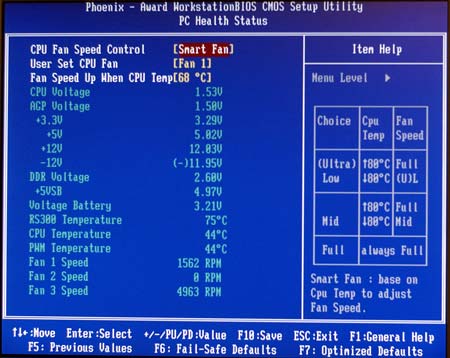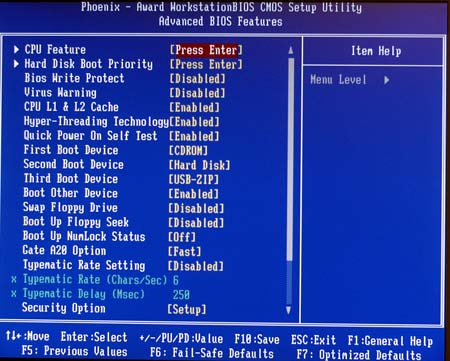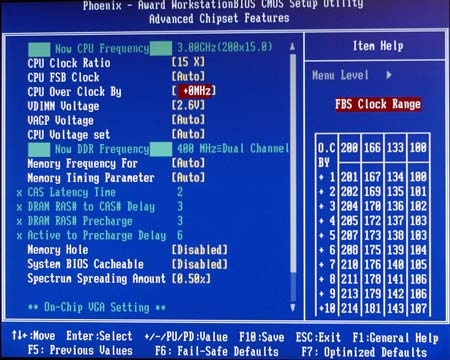Shuttle XPC ST61G4: Tiny Computer with Big Integrated Video
by Wesley Fink on January 23, 2004 12:23 PM EST- Posted in
- Systems
Shuttle XPC ST61G4: BIOS and Overclocking
Lately, Shuttle has been equipping their SFF computers with flexible BIOS options that allow the enthusiast to get the most from their SFF system. The ST61G4 is no exception, providing the full array of options that computer enthusiasts have come to expect in their motherboards, whether full-size or SFF.
Shuttle uses the familiar Phoenix-Award Bios in the ST61G4. The menu/submenu arrangement will be familiar to most users.

A full PC Health submenu with Smart Fan adjustments and a complete readout of fan speeds, temperatures, and power levels is provided. Shuttle pioneered the kind of fan controls on SFF that can deliver whisper-quiet day-to-day operation. The PC Health section continues the refinement of fan and thermal controls on Shuttle systems.

You will find the expected range of adjustments and boot sequence options in the Advanced BIOS Features section.

Instead of a separate Frequency/Voltage Control tab, Shuttle has included most of the voltage, memory timing, and FSB adjustments in the Advanced Chipset Features section.
It is important to point out, however, that the ST61G4 will not operate at any timings faster than 2-3-3-6 with either our Mushkin or OCZ test memory. The Mushkin SPD is programmed at 2-2-2-6 at DDR400, but the ST61G4 BIOS resets timings to 2-3-3-6. If you force the timings to 2-2-2-6 or 2-2-3-6 with either the Mushkin or OCZ memory the Shuttle will not boot. In comparison, both the OCZ and Mushkin perform fine at 2-2-2-5 or 2-2-2-6 settings at DDR400 in almost every Intel, nVidia, SiS, and VIA chipset motherboard. We do sometimes need to slow to 2-2-3-6 timings on certain boards, but the ST61G4 is the first board we have tested in quite a while to require 2-3-3-6 memory timings to operate.

FSB is officially adjustable to a unexpectedly low 232 setting, but adjustment is by the very odd selection of 1 to 15, which does not represent FSB increments at all. Shuttle includes a table to help in understanding the actual FSB that you are setting.
As usual, Shuttle has provided a complete selection of overclocking options, even if they are somewhat unfamiliar as implemented in the ATI 9100IGP. The FSB is extremely limited for a current Intel processor motherboard. This is particularly true when you consider many end-users are now easily reaching 250FSB at default voltage with air cooling using recent Intel processors. With a new and robust 250-watt power supply, which is huge by SFF standards, overclocking capabilities should not be held back by the power supply. This makes the BIOS limitation of a maximum FSB of 232 particularly puzzling.
FSB Overclocking Results
The last system that you normally think about overclocking would be a Small Form Factor, but as we demonstrated in our tests of the Shuttle, Soltek, and Biostar, the overclocking abilities can be outstanding on the latest SFF systems. We agree that you buy a system like the Shuttle ST61G4 for the small size and quiet operation. However, since we have proved in the past that you don't have to give up anything in a SFF system, we have made overclocking tests a standard part of SFF reviews.| Front Side Bus Overclocking Testbed | |
| Processor: | Intel 3.0 800FSB Pentium 4 |
| CPU Voltage: | 1.525V (default) |
| Cooling: | Shuttle ICE Cooling System |
| Memory: | 2 x 512MB Mushkin PC3500 Level II DS |
| Power Supply: | Shuttle Silent X 250W |
The highest stable FSB overclocking that we could achieve at default voltage was a very disappointing 213MHz at the +9 BIOS setting (852FSB) while running either the onboard ATI 9100IGP graphics or an ATI Radeon 9800 PRO. Since this CPU is known to do 3.6GHz+ at default voltage on many Pentium 4 mainboards, we can only conclude that the ATI chipset is currently holding back overclocking.
Increasing the CPU voltage and further relaxing memory timings did not really help in reaching a higher overclock. Nothing we tried would provide a completely stable system at the +10 setting of 214.
At 3.195 GHZ, the ST61G4 was completely stable. We ran the machine overnight, stress-tested, ran benchmarks, and still could not get the system to fail.
With the incredible headroom of current Intel processors, we can only hope ATI and Shuttle do not continue to ignore the overclocking capability of future ATI chipsets. This limited capability can seriously hamper sales when it is being compared to the excellent overclocking abilities of current Intel chipsets. We were particularly disappointed because the new 250-watt Silent X has the kinds of reserves that can take the tiny SFF machines to new levels of overclocked performance.










17 Comments
View All Comments
Cygni - Sunday, January 25, 2004 - link
The IGP performance was stellar... if your going to be using the onboard graphics, this box looks like a good choice... but if your going to be using the AGP slot, the i865G looks better.sipc660 - Saturday, January 24, 2004 - link
i think my laptop is running the same ati igp chipset and apart from the crappy celery i noticed performance could be somewhat better..but i don't think that the memory timings are forced that slow..could it be that the shuttle wanted to keep off any possible temperature issues?
i noticed anything video and or memory intensive turns my rather quite laptop into a godzilla.
i reckon anyone purchasing SFF should still get the shuttle and wait for a bios update....that should close the resulting performance gap
why?
ban the freakin 3andHalf floppy drives...
sipc660 - Saturday, January 24, 2004 - link
gamara - Saturday, January 24, 2004 - link
The onboard nForce2 was tested in a previous review, and had better onboard video performance with a processor that cost $80(Athlon XP 2600+) instead of $260(P4 3.0). Not sure if the settings were the same, as the previous article did not list what settings it was tested with.ATI 98 FPS Q3, 50 UT 2003 Flyby, and 38 UT Bot
NForce2 129 Q3, 66 UT Flyby, and 38 UT Bot. Not bad for giving up 1 Ghz on the processor.
artifex - Friday, January 23, 2004 - link
this may sound stupid, but how do you install Windows to the onboard RAID without a floppy for the RAID driver? Not to mention... where does the other drive in the RAID go? :)Lonyo - Friday, January 23, 2004 - link
ATi - Pentium 4, Intel - Pentium 4. nVidia - AMD.Rako00 - Friday, January 23, 2004 - link
Why compare the ATI to intels intergreated graphics card only. At least include the Nforce 2 graphic card too.